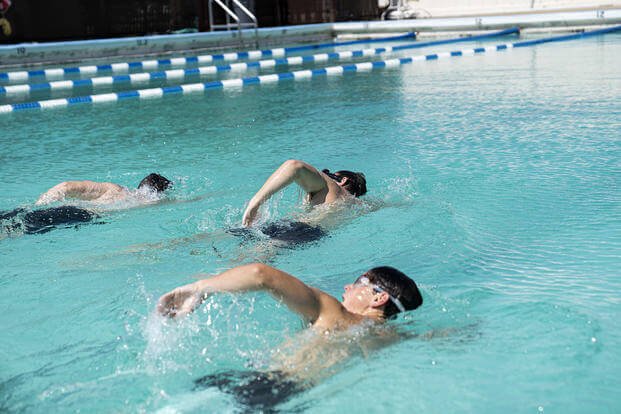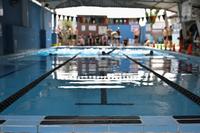Setting fitness performance goals is a fun way to help you stay consistent with your weekly training. I advise focusing on two types of goals when setting a performance starting line for special-ops level training: a consistency goal per week and a performance goal every two weeks.
Here is a great question from a gentleman working to improve combat rescue officer (CRO) scores on the Air Force Special Warfare Initial Fitness Test (IFT):
What is a realistic time to drop off a 3-mile run and a 1500m swim (Air Force Special Warfare CRO test) per week? I want to set reasonable goal increments for my upcoming training block. I am currently able to finish both -- just too slowly. Thanks, Taylor
Taylor, that's a great question. I do not think you will see weekly performance gains, so I would avoid taking a fitness test each week. Perhaps every other week, at the most, is better. However, the more you take the IFT, the better you will become at taking it and creating useful strategies to maintain pace, develop good nutritional practices (fueling) and improve at test-taking.
But you can mix in elements of the IFT into your training week. There is nothing wrong with doing a three-mile timed run after the calisthenics and lift section of your workout, just as there is nothing wrong with doing the swim workout last (as it appears in the IFT order). This swim workout can have days where you do a 1,500-meter test as a workout, but you should monitor pacing throughout the test and work hard to maintain a meter-per-second pace.
Pacing the Run and Swim
My advice is to spend more time weekly focusing on the pace you desire to score on the IFT and working on it with smaller distances in the run and swim. For instance, do a run workout with three miles of 400-meter runs at a goal mile pace, with a 100-meter walk in-between. Then try a run workout with three miles of 800-meter runs at that same goal pace, with a 100- to 200-meter walk after each interval. For a great challenge, try the "mile repeat" workout, where you do one mile at your goal pace, rest with a 400-meter walk and repeat for 3-4 total miles.
Defining Goal Pace for Swim and Run
Work hard to build up to a seven-minute mile run first so you can do the three miles in 21 minutes. Once you have mastered that for your timed run, adjust your goal mile pace to between six minutes and 6:30. This will get the three-mile run down to an 18-minute to 19:30 range. You will see that these pacing workouts get easier every few weeks, and you can pick up the pace as desired to meet your goal time of 18-18:30 for the three-mile run.
The same holds for the 1,500-meter swim. You will want to be in the pool at least 4-5 days a week to see the proper conditioning improvements. Start off with a 45- to 50-second, 50-meter swim. Continue for 10-15 sets. Then see whether you can do the same with a 100-meter distance for 10-15 sets.
Now you are flirting with your testing distances and working on your stamina to maintain that level pace for 3 x 500-meter swims. Just like you built up to mile repeats in the running for your three-mile test, build up to 500-meter repeats for the level of conditioning needed to see progress in your 1,500-meter swim test.
If you can work your technique and conditioning to swim 500 meters in eight minutes to 8:30, you have a solid chance at building your swim time to 24-26 minutes for the 1,500-meter test, which is a very competitive score after doing a max-rep set of pull-ups, sit-ups, push-ups and a three-mile run.
This is one of the harder fitness tests in the military, and it requires a progressive buildup of near-daily running and swimming to excel at the level you want to be competitive. Keep it up and remember: If you are not assessing, you are only guessing. It is good to set goals and assess how your training is working.
A good weekly goal is to focus on consistency, but a bimonthly or monthly goal should be to assess how your training is coming along. Maintaining your goal pace for a little longer than before is a good goal. For example, if you can do 400 meters at 1:30 (six-minute pace) for six sets at the beginning of the month, but can now hold that pace for 12 sets, that is huge progress. Same for the swim. If you can hold the pace for 500 meters (a meter per second) but now can hold it for 750-1,000 meters, that is great progress. Seek progress every 2-4 weeks.
Stew Smith is a former Navy SEAL and fitness author certified as a Strength and Conditioning Specialist (CSCS) with the National Strength and Conditioning Association. Visit his Fitness eBook store if you're looking to start a workout program to create a healthy lifestyle. Send your fitness questions to stew@stewsmith.com.
Want to Learn More About Military Life?
Whether you're thinking of joining the military, looking for fitness and basic training tips, or keeping up with military life and benefits, Military.com has you covered. Subscribe to Military.com to have military news, updates and resources delivered directly to your inbox.


















